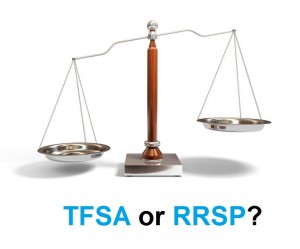
Photo by: winnifredxoxo licensed under Creative Commons Attribution 2.0 Generic Image has been modified.
A recent online survey conducted in November by Ipsos Reid showed that of over 1200 Canadians, 36% aren’t even contributing to an RRSP (Registered Retirement Savings Plan). If that many people aren’t taking advantage of this age-old investment vehicle, imagine how many are not using the much newer TFSA (Tax Free Savings Account). Add to that the difficulty in deciding which vehicle to prioritize when extra savings are found, and there is a lot of education left to do. When deciding where to place tax-sheltered savings before tax time, let’s first review the basics.
Let’s begin by talking about the difference between an RRSP and a TFSA. This is a very common question, but a better place to start is to explain the similarities. Both of these options are registered accounts, meaning that they are set up through your financial institution and registered with the Canadian government so that the funds within can enjoy tax-sheltered status as they grow. That means no tax needs to be paid on the capital growth that you enjoy within these accounts while the money is still within them. Both accounts have annual limits, but unused portions carry forward to future years and accumulate over time.
The TFSA allows Canadian residents over age 18 to contribute up to $5,500 each year to this account (up from the $5,000 limit that existed between 2009 – 2012). You must use after-tax income to invest in this account. Investment income earned in a TFSA is, however, tax-free, and withdrawals are tax-free as well. So if, for example, you purchase $1000 worth of a particular stock or bond that doubles in value to $2000, you will not be expected to pay capital gains tax on the extra $1000 you gained, even if you sell the stock and remove the money from your TFSA account. This is an excellent way to earn tax-free investment income to help meet your lifetime savings needs. When thinking of retirement, it is also good to know that income earned and withdrawals made from a TFSA post-retirement will not affect a person’s eligibility for federal income-tested benefits such as Old Age Security or the Guaranteed Income Supplement, and TFSA assets can be transferred, generally tax-free, to a spouse upon death.
The RRSP, by contrast, can be contributed to with either pre-tax income or after-tax earnings, but contributing through your paycheque (as many employers can facilitate) provides instant tax-sheltering of those monies. After-tax contributions will provide additional tax relief by reducing your tax owed in the calendar year(s) in which you contribute because the amount contributed can be deducted from your gross income. The annual RRSP contribution limit is based on a percentage of your income (less pension adjustments). There is no minimum age for setting up an RRSP, but the maximum age for contributing is 71. While your investments within an RRSP can grow in a tax-sheltered environment, unlike a TFSA, you will be expected to pay income tax on amounts withdrawn from your RRSP after you retire, as those monies will be considered income.
So now that we have reviewed the finer details of TFSAs and RRSPs, let’s explore a few common scenarios and discuss where you should put your savings this year, and how you should choose between the two types of account.
The most important thing to look at is your current income and your current tax rate. If you are saving for retirement, the RRSP is the best option if your income tax rate today is higher than or equal to what you expect it to be in the future when you retire. Grab the added tax benefits now, when you are in the higher tax bracket. Once your earnings are less (ex: when you are retired and drawing funds from your RRSP as income), your overall tax owed will also be less. The TFSA would only be the better option if you foresee yourself at a higher tax rate in the future. In that situation, there would be no sense putting funds into an RRSP today simply to enjoy tax benefits now when you will have to pull the money back out later on at an even higher tax rate. This requires anticipating and mapping out the income you will receive later in life from pensions, government benefits, and your own retirement savings. A great conversation to have with your financial planner.
In the same vein, if you are counting on government support in retirement, such as the Guaranteed Income Supplement or Old Age Security, the TFSA may be a helpful choice. Those particular government benefits are based on strict income guidelines. If you go over the maximum income eligibility amounts, you will be subject to clawbacks. TFSA withdrawals won’t impact your declared income when you withdraw monies (unlike RRSP withdrawals), leaving your eligibility for those benefits unaffected. If you have a great pension, the amount you receive, combined with RRSP withdrawals post-retirement, could push you into an income level that forces the clawback of those benefits (the most recent amount that forces clawbacks is $70,954), but if you are just using TFSA withdrawals to supplement your pension, you could avoid those clawbacks altogether since your income claimed will be lower.
If you’ve simply got extra money for savings this year and looking to store it away for something shorter-term, like a new car, home renovations, or even just an emergency fund, then use the TFSA before the RRSP. You won’t be penalized when you withdraw funds so accessing the money pre-retirement is easy and penalty-free.
As you can see, there are many detailed and highly personal considerations to be made when considering whether to prioritize RRSPs or TFSAs, and we’ve only just scratched the surface here. Give us a call today and we’ll be happy to walk you through the process and find the best solution for you and your family, or download our FREE Consumer Awareness Guide on How To Choose and Work With a Financial Planner You Can Trust.
















